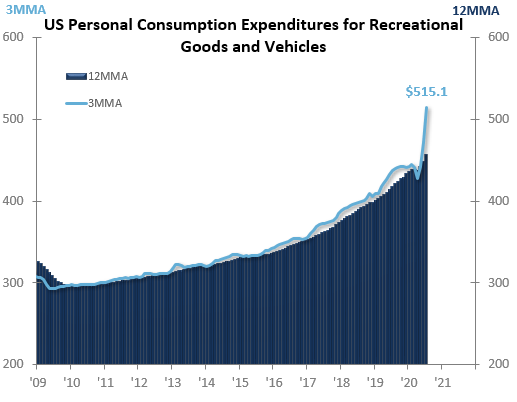As a nation, we are strong, we are resilient, and we like to have fun. While many industries have been hurt due to COVID-19, socially-distanced leisure activities can’t keep up with consumer demand.
During the summer of 2020, people were kept from flying to new locations, going to baseball games, attending concerts, and participating in other public outings, which meant consumers couldn’t spend the way they typically do. With US disposable personal income jumping to a record high in April and staying above pre-COVID levels despite the recession, consumers have even more money to spend than normal and are looking for ways to spend it. And here is where the socially-distanced leisure activities come in.
Recreational goods and vehicles consumption were at record highs in February 2020. As uncertainty hit the economy and widespread shutdowns caused many industries to come to a halt, the same occurred for the recreational industry. However, this sector of the economy roared back to life in May and carried on strong through summer. The shutdowns of March and April could have created some pent-up demand that fueled the May and June numbers, but there is more to it than that. Our desire to play during the summer – to find ways to enjoy our time and still be safe – fueled much of the demand.
Personal Consumption Expenditures for Recreational Goods and Vehicles, which include everything from pleasure boats and recreational vehicles to video games and musical instruments, are at a record high, and Expenditures for the recent quarter were up 17.8% from the prior year. This is the strongest this market has grown in over 33 years, and, what’s more, the last time Expenditures grew at such an accelerated rate, the market was only 17.6% of its current size.

While summer may be coming to an end, playtime isn’t over. Our expectation is that demand for recreational goods will remain elevated at least into the first half of 2021. A widely available vaccine is unlikely before next spring, and even if there is a widely available vaccine before the summer of 2021, hesitancy will likely keep consumers cautious about their interactions into at least next summer. Supply of both parts and labor is likely to be one of the bigger challenges for the recreational goods and vehicles industry. Ensure you have multiple sources for materials. You may have to get creative with your hiring and employee retention. Despite relatively high unemployment rates, finding the right employee remains a challenge.
If you are unsure how you can capitalize on this trend, give us a call; we’re happy to help!
Jackie Greene
Director of Economics